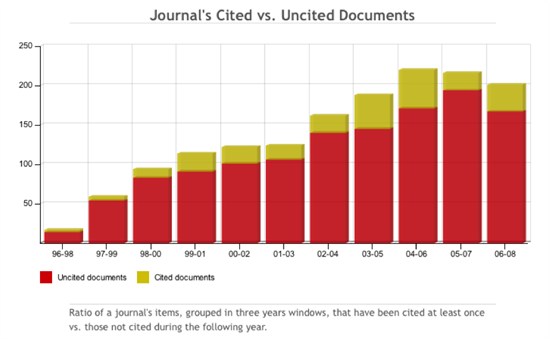Christian Hunt
21.04.2011 | 4:30pmPost 3 of 3
The list of ‘900+’ papers linked to by the Global Warming Policy Foundation as supporting climate scepticism included more articles published in Energy and Environment than any other journal.
We reported last week that nine out of the top 10 authors listed by the GWPF were linked to ExxonMobil. We also discovered that prominent scientists featured on the list didn’t agree that their work supported skepticism about anthropogenic global warming – and had unsuccessfully asked for their work to be removed from similar lists in the past.
We used the same data analysis tools to examine where the papers on the list were published. The most cited journal by a clear margin was Energy and Environment, which provided 131 papers to the list – almost 15 percent of the total.
Energy and Environment’s editor Sonja-Boehmer Christiansen has said that she is “following [her] political agenda” in editing the journal, which is co-edited by Benny Peiser, director of the Global Warming Policy Foundation.
Christiansen noted in evidence submitted to the UK Parliament that E&E has been characterised as ” a journal of choice for climate skeptics,” also stating: “If this [is] so, it happened by default as other publication opportunities were closed to themâ?¦”
It is unclear whether E&E is peer-reviewed. The journal is not listed by the ISI Web of Knowledge, which provides “comprehensive coverage of the world’s most important and influential journals“. E&E has been described by Gavin Schmidt of the science blog RealClimate as having “effectively dispensed with substantive peer review for any papers that follow the editor’s political line”.
One way to consider a journal’s relative importance within its field is to examine its impact factor – the number of times the average journal paper is cited over a two year period.
SCImago journal rank shows that the average paper published in E&E has an impact factor of around 0.42 – less than one citation every four years. Nature, one of the most central scientific journals in this field, has an impact factor of around 30. The Journal of Climate, a mainstream but smaller climate journal, has an impact factor of 3.57.
SCImago also provides citation information for every journal it lists – the first graph shows the number of times journal articles in E&E were cited in individual years. The second, by way of comparison, shows the same information for the Journal of Climate.

Citation statistics for Energy and Environment.

Citation statistics for the Journal of Climate.
It’s clear that E&E’s papers are cited relatively infrequently – suggesting the inclusion of a substantial number of them on the ‘900+’ list does not demonstrate widespread disagreement with the scientific consensus on climate change, but rather that these views are confined to a small climate skeptic lobby.
So in summary, what is the significance of this list of papers?
There are a few respected scientists who are skeptical about man-made climate change – Richard Lindzen is one. Similarly, it’s possible to find scientific papers which question the theory – particularly if you look further back in time before scientific certainty on this issue solidified.
But by examining this list in more detail, it becomes clear that rather than capturing broad scientific opposition to the reality of manmade climate change:
A significant chunk of the list is authored by a small group of writers with extensive links to each other and to the oil industry.
The most cited source for the ‘peer reviewed papers’ featured is a minor journal which appears to have a political agenda to promote climate skepticism.
Not only do many of the other papers on the list either support the scientific consensus on climate change, or not discuss human influence on the climate, we found several cases where scientists featured on the list described the inclusion of their work as misleading.
It seems like these facts should make the genuinely skeptical reassess how significant this list of papers is.
Read part 1: 9/10 top authors linked to Exxon
Read part 2: “Using our paper is misleading”

